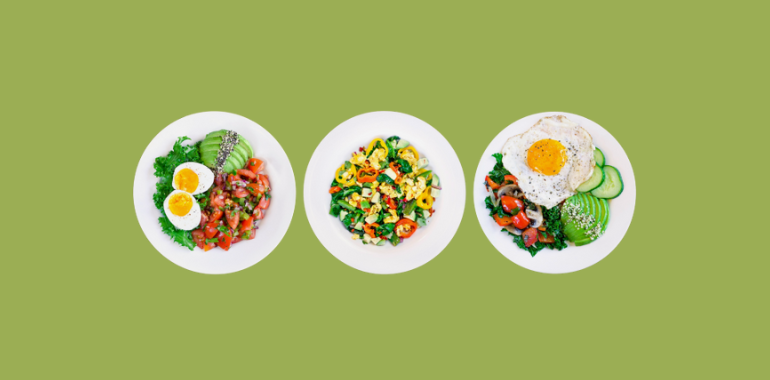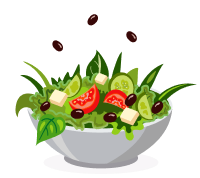Table Of Contents
What is The Pegan Diet & How it Promotes Weight Loss and Overall Health
The pegan diet combines the best elements of paleo and vegan eating approaches, offering a balanced nutritional framework that promotes both weight loss and health optimization. Created by Dr. Mark Hyman, this innovative dietary approach consists of approximately 75% plant foods and 25% high-quality animal products. By focusing on whole, unprocessed foods while limiting dairy, grains, and sugar, the pegan diet helps regulate blood sugar, reduce inflammation, and support sustainable weight management.
Unlike strictly vegan or paleo diets, pegan eating offers more flexibility while still delivering impressive health benefits. This 21-day approach emphasizes nutrient-dense vegetables, healthy fats, quality proteins, and strategic carbohydrate choices that can transform your relationship with food and improve your overall wellbeing.
The Core Principles of the Pegan Diet
At its foundation, the pegan diet blends key elements from both paleolithic and vegan philosophies. This hybrid approach emphasizes whole, unprocessed foods that our bodies are naturally designed to digest and utilize effectively. Unlike purely plant-based regimens, the pegan diet incorporates modest amounts of animal products, focusing on quality and ethical sourcing.
The pegan diet prioritizes nutrient density over calorie counting. It guides followers to fill approximately 75% of their plate with plants and the remaining 25% with carefully selected animal-based foods. This balance helps optimize vitamin and mineral intake while maintaining appropriate protein levels for tissue repair and muscle maintenance.
Why Dr. Mark Hyman Created the Pegan Diet
Dr. Mark Hyman, a renowned functional medicine practitioner, developed the pegan diet in 2014 after observing limitations in both paleo and vegan approaches. He recognized that while both diets had merits, neither provided the optimal balance many patients needed for sustainable health improvements.
Hyman created this dietary framework to address modern nutritional challenges while honoring ancestral wisdom about food. He sought to combine the anti-inflammatory benefits of plant-focused eating with the protein optimization of ancestral diets. This balanced approach helps prevent nutritional deficiencies commonly seen in strict vegan diets while avoiding the excessive animal product consumption sometimes associated with paleo eating.
The pegan diet also reflects Dr. Hyman’s commitment to environmental sustainability by advocating for responsibly raised animal products and organic produce. This consideration makes the diet not just about personal health but planetary wellbeing too.
Essential Components of a 21-Day Pegan Diet Plan
A successful 21-day pegan diet plan balances nutrient-dense foods according to specific proportions. The plan centers around whole, fresh foods with approximately 75% coming from plants and 25% from animal sources. This framework provides ample vitamins, minerals, and phytonutrients while maintaining adequate protein intake.
The USDA’s recommendations for calorie, macronutrient, and micronutrient requirements can be met on the pegan diet with careful planning. By prioritizing nutrient-rich options and avoiding processed foods, followers can achieve weight management goals while supporting overall health.
- Focus on whole foods including colorful fruits, vegetables, meats, and nuts
- Balance your plate with 75% plant-based and 25% animal-based foods
- Choose animal proteins that are sustainably raised with minimal environmental impact
- Limit processed foods, dairy products, and gluten-containing grains
Vegetables: The Foundation of Your Pegan Plate
Vegetables form the cornerstone of the pegan diet, ideally covering more than half of your plate at each meal. The World Health Organization recommends a minimum of 5 servings of fruits and vegetables daily, but the pegan approach takes this further, suggesting 15 servings—approximately 7-8 cups—throughout the day.
Emphasize colorful, non-starchy vegetables like leafy greens, broccoli, peppers, and cucumbers. These provide essential vitamins, minerals, and phytonutrients that support cellular health while keeping blood sugar levels stable. The vibrant colors indicate different antioxidant profiles, each offering unique health benefits.
While vegetables of all types are encouraged, the pegan diet suggests moderating intake of starchy options like potatoes and squash. Instead, focus on green, leafy varieties and other low-glycemic vegetables that provide maximum nutrition with minimal impact on blood sugar levels.
Healthy Fats: Your Priority Nutrient Source
Healthy fats play a crucial role in the pegan diet, serving as both energy sources and essential building blocks for hormones and cell membranes. The diet emphasizes whole food fat sources rather than processed oils, maximizing nutritional value and minimizing inflammatory compounds.
For uncooked foods, extra virgin olive oil provides heart-healthy monounsaturated fats and potent antioxidants. When cooking at higher temperatures, avocado oil or organic virgin coconut oil offer greater stability and beneficial fatty acid profiles.
Animal-based fat sources include fish rich in omega-3 fatty acids, eggs from pastured hens, and limited amounts of grass-fed butter or ghee. Plant-based options feature avocados, olives, and various nuts and seeds. This diverse fat profile supports cognitive function, hormone production, and nutrient absorption while promoting satiety—key factors in successful weight management.
Nuts and Seeds: Powerhouse Nutrition
Nuts and seeds deliver concentrated nutrition in the pegan diet, offering protein, healthy fats, and various micronutrients in convenient packages. These foods play significant roles in managing chronic conditions including diabetes, heart disease, and obesity.
The pegan approach emphasizes raw, unsalted varieties of nuts like almonds, walnuts, and pecans. Seeds such as flax, chia, and hemp provide exceptional nutrition profiles, including omega-3 fatty acids and complete proteins. These ingredients can be incorporated into meals as toppings, blended into smoothies, or enjoyed as between-meal snacks.
Despite their caloric density, nuts and seeds promote weight management through their satiating properties and favorable impacts on metabolism. Their fiber content supports digestive health while their mineral profiles, including magnesium and zinc, contribute to numerous bodily functions from nerve signaling to immune support.
Fruit Consumption: Quality Over Quantity
The pegan diet takes a measured approach to fruit consumption, differentiating between low-glycemic options and those with higher sugar content. While all fruits offer valuable nutrients, their varying impacts on blood sugar levels inform consumption recommendations.
For those maintaining healthy weight and metabolism, a wide variety of fruits can be enjoyed regularly. However, individuals working toward weight loss goals or managing blood sugar concerns should focus primarily on berries and other low-glycemic fruits. These provide maximum nutritional benefit with minimal glycemic impact.
Rather than eliminating higher-sugar fruits entirely, the pegan approach suggests treating them as occasional enjoyments rather than daily staples. This balanced perspective acknowledges both the nutritional benefits of fruit and the importance of moderating natural sugars for optimal metabolic health.
Meat as a Side Dish, Not the Main Event
The pegan diet reimagines the traditional Western plate by positioning meat as a complementary element rather than the centerpiece. Portions typically range from 4-6 ounces per meal—roughly the size of a smartphone—allowing animal proteins to enhance nutrition without dominating the plate.
Quality takes precedence over quantity, with emphasis on ethically raised animals fed their natural diets. Grass-fed beef, pasture-raised poultry, and wild-caught fish deliver superior nutrition profiles compared to conventionally raised alternatives, including healthier fat compositions and fewer contaminants.
For the adventurous, alternative protein sources like cricket protein powder offer sustainable, nutrient-dense options. These emerging protein sources provide complete amino acid profiles with minimal environmental impact, aligning with the pegan diet’s dual focus on personal and planetary health.
The Strategic Role of Beans in Your Pegan Diet
Beans occupy a middle ground in the pegan diet—neither fully embraced nor completely restricted. While they provide valuable fiber, protein, and minerals, their carbohydrate content and potential digestive challenges warrant thoughtful consumption.
Dr. Hyman suggests limiting bean consumption due to their starch content, which can raise blood sugar levels in sensitive individuals. Additionally, compounds like lectins and phytates may interfere with nutrient absorption for some people, though proper preparation techniques like soaking and thorough cooking can mitigate these effects.
Rather than eliminating beans entirely, the pegan approach recommends moderate portions—typically no more than one cup daily—and careful attention to how your body responds. Lentils, chickpeas, and smaller beans tend to be more digestible options that can provide valuable nutrition while supporting stable blood sugar levels.
Whole Grains: Limited But Purposeful Choices
The pegan diet takes a selective approach to grains, limiting them more stringently than standard dietary guidelines but less severely than strict paleo protocols. This moderation reflects concerns about gluten sensitivity, blood sugar impacts, and potential inflammatory responses in susceptible individuals.
When incorporating grains, the pegan approach favors low-glycemic options like quinoa, black rice, and amaranth. These ancient or pseudo-grains provide more balanced nutrition profiles than modern wheat varieties while having gentler effects on blood sugar levels.
Portion control remains important even with these preferred grain choices. Typically, grains should occupy no more than a quarter of the plate and may be rotated with other starchy foods rather than consumed at every meal. This strategic approach allows for nutritional diversity while maintaining metabolic health.
Sugar: Treating It as an Occasional Indulgence
The pegan diet takes a firm stance on sugar, recognizing its significant impact on metabolism, inflammation, and overall health. Rather than focusing solely on obvious sources like candy and soda, this approach acknowledges the hidden sugars in processed foods, sauces, and even supposedly healthy options.
All forms of refined sugar—including granulated sugar, corn syrup, and processed carbohydrates—are considered occasional treats rather than dietary staples. This guideline applies regardless of marketing claims about natural or organic status, as the metabolic effects remain similar.
When sweetness is desired, the pegan approach recommends small amounts of natural sweeteners like raw honey, maple syrup, or monk fruit extract. Even with these better options, moderation remains essential, with emphasis on training the palate to appreciate the natural sweetness found in whole foods like berries and sweet vegetables.
Dairy: Why the Pegan Diet Recommends Reduction
The pegan diet generally recommends limiting or avoiding dairy products, citing concerns about both health impacts and production methods. Dr. Hyman points to potential connections between dairy consumption and various health conditions, including allergies, digestive issues, and inflammatory responses.
From an environmental perspective, conventional dairy production raises concerns about animal welfare and ecological footprints. The intensive resource requirements and waste management challenges of large-scale dairy operations factor into the pegan diet’s recommendation to minimize consumption.
For those who include some dairy, the pegan approach suggests highly selective choices—specifically grass-fed, organic options consumed in limited quantities. Fermented dairy products like yogurt or kefir from grass-fed sources may offer better digestibility and nutritional profiles than milk or cheese, making them occasional options for those without dairy sensitivities.
Avoiding Preservatives and Additives: The Clean Eating Approach
The pegan diet emphasizes food purity, advocating for products free from artificial additives, preservatives, and synthetic chemicals. This clean eating approach extends beyond ingredient lists to consider how foods are grown, raised, and processed before reaching your plate.
Specifically, the pegan guidelines recommend avoiding foods containing hormones, antibiotics, pesticides, herbicides, artificial colors, chemical preservatives, and synthetic sweeteners. Additionally, genetically modified organisms (GMOs) are approached with caution due to concerns about their long-term health and environmental impacts.
This focus on food quality aligns with growing research on how non-nutritive food components can affect health outcomes. By minimizing exposure to potentially problematic compounds, the pegan diet seeks to reduce overall toxic burden while maximizing the body’s access to beneficial nutrients in their most bioavailable forms.

Health Benefits of the Pegan Diet
The pegan diet offers multiple health advantages through its focus on nutrient-dense foods and strategic elimination of potentially problematic ingredients. While research specifically examining the pegan diet remains limited, its components have substantial scientific backing.
According to Dr. Rajagopal, the pegan approach shares beneficial elements with well-studied eating patterns like the Mediterranean diet, particularly in its emphasis on whole foods and healthy fats. Its restriction of dairy and certain grains may provide additional benefits for those with specific sensitivities.
The abundant intake of fruits and vegetables provides essential nutrients that help prevent chronic conditions including obesity, type 2 diabetes, heart disease, and systemic inflammation. The diet’s focus on whole foods naturally limits processed items and added sugars, creating favorable conditions for weight management and metabolic health.
Blood Sugar Management: The Low GI Advantage
The pegan diet excels at blood sugar regulation through its emphasis on low-glycemic foods. By prioritizing vegetables, proteins, and healthy fats while limiting refined carbohydrates and sugars, this eating approach naturally helps maintain steady glucose levels throughout the day.
According to research published in medical journals, low glycemic index eating patterns show particular benefits for individuals with insulin-related conditions such as diabetes, pre-diabetes, or metabolic syndrome. The pegan diet’s focus on identifying and favoring foods with minimal blood sugar impact aligns with these evidence-based approaches.
Beyond specific conditions, stable blood sugar benefits everyone by reducing energy fluctuations, minimizing cravings, and supporting consistent cognitive function. These advantages make the pegan diet’s glycemic approach valuable even for those without diagnosed metabolic concerns.
Sustainable Eating: Environmental Benefits
The pegan diet addresses environmental concerns that can arise from both traditional omnivorous and strict vegan approaches. By recommending moderate meat consumption from sustainable sources, it reduces the ecological footprint associated with intensive animal agriculture without eliminating animal products entirely.
Research from academic nutrition journals indicates that this balanced approach may offer optimal sustainability. The diet’s emphasis on locally grown, organic produce further reduces transportation emissions and chemical impacts, while its seasonal focus supports biodiversity and regional food systems.
By considering both personal and planetary health, the pegan diet represents a practical compromise that acknowledges the complex interplay between nutrition and environmental stewardship. This holistic perspective distinguishes it from more extreme dietary approaches that may excel in one area while creating challenges in another.
The Pegan Diet Food List: What to Embrace
The pegan diet emphasizes filling approximately 75% of your plate with plant foods at each meal. Dr. Hyman recommends including two to three vegetable servings per meal, focusing primarily on non-starchy varieties that support stable blood sugar levels.
For those following a low-glycemic approach within the pegan framework, these vegetables form the foundation of your daily intake. Their high fiber content and minimal impact on blood glucose make them ideal choices for metabolic health and weight management.
Vegetables and Fruits to Prioritize
On the pegan diet, plant foods comprise the majority of your intake, with special emphasis on low-glycemic vegetables. These nutrient-dense options provide maximum nutritional benefit with minimal blood sugar impact:
- Leafy greens (kale, spinach, collards, arugula)
- Cruciferous vegetables (broccoli, cabbage, Brussels sprouts)
- Non-starchy vegetables (asparagus, peppers, zucchini, tomatoes)
- Low-sugar fruits (berries, green apples, citrus)
For optimal nutrition, aim for vibrant color diversity in your plant selections. Different pigments indicate various phytonutrient profiles, each offering unique health benefits from antioxidant protection to anti-inflammatory effects.
Recommended Protein Sources
The pegan diet emphasizes quality protein sources in moderate amounts, focusing on options that are both nutritionally superior and environmentally responsible:
- Grass-fed, pasture-raised meats (beef, lamb, bison)
- Pasture-raised poultry and eggs
- Wild-caught, low-mercury fish and seafood
- Limited amounts of tempeh or tofu (organic, non-GMO)
These proteins should be consumed in appropriate portions—typically 4-6 ounces per meal—and treated as supporting elements rather than meal centerpieces. This approach ensures adequate amino acid intake while avoiding the potential health and environmental concerns associated with excessive animal product consumption.
Healthy Fats for Optimal Nutrition
Healthy fats play a crucial role in the pegan diet, providing essential fatty acids, supporting hormone production, and enhancing nutrient absorption. The diet recommends these fat sources:
- Omega-3 rich sources (wild fish, flaxseeds, walnuts)
- Monounsaturated fats (avocados, olives, extra virgin olive oil)
- Coconut products (including unrefined coconut oil)
- Nuts and seeds (especially chia, hemp, and pumpkin seeds)
- Limited amounts of saturated fats from grass-fed animals
The pegan approach avoids industrial seed oils (like soybean, corn, and cottonseed) due to their potentially inflammatory omega-6 content and processing methods. Instead, it favors minimally processed fats that retain their natural nutrient profiles and beneficial compounds.
Is the Pegan Diet Right for You?
Before embarking on the pegan diet, consider consulting with a healthcare provider, especially if you have existing medical conditions. Since this eating approach eliminates several food groups, careful planning is necessary to ensure nutritional adequacy. Individuals with conditions like iron or B12 deficiency may require special consideration, as might those with osteoporosis who need sufficient calcium and vitamin D.
From a practical standpoint, the pegan diet can be more financially demanding than standard eating patterns. Grass-fed meats and organic produce typically cost more than conventional alternatives. The limited use of legumes—an economical protein source—further increases the diet’s expense.
Protein, iron, and vitamin B12—all of which are included in meat, eggs, and tofu—should all be consumed in sufficient amounts. A minimum of 1,000 mg of calcium per day is also necessary; older or pregnant adults require much more. Find out how to acquire your recommended daily dose of calcium by speaking with your doctor or a trained nutritionist.
The CDC’s guidelines for healthy eating include whole grains, beans, and legumes—all items that the pegan diet significantly restricts. While these limitations may benefit specific individuals with food sensitivities or metabolic conditions, they may be unnecessarily restrictive for others.
You don’t need to adopt all pegan principles to gain benefits. Even incorporating some elements—like increasing vegetable intake or choosing better quality animal products—can improve your nutritional status without requiring a complete dietary overhaul.
Pegan Diet Breakfast Ideas for Weight Loss
Breakfast sets the metabolic tone for your entire day, making it a crucial component of the pegan diet, particularly for weight management. Dr. Hyman emphasizes that a properly composed morning meal helps stabilize blood sugar, control cravings, and optimize energy levels throughout the day.
An ideal pegan diet breakfast typically includes quality protein from eggs, fish, or leftover meat, combined with healthy fats from avocados or nuts. Add fiber-rich berries or low-glycemic fruits, then complete the meal with vegetable-based carbohydrates for a perfectly balanced start to your day.
- Almond flour pancakes made with eggs and monk fruit sweetener, topped with fresh blueberries
- Green smoothie combining coconut milk, grass-fed beef protein, half a banana, and avocado
- Scrambled eggs with sautéed mushrooms, bell peppers, and sliced avocado
- Chia pudding prepared with collagen protein and topped with berries
- Vegetable scramble with spinach, mushrooms, and yellow squash cooked in coconut oil with pastured eggs
- Body-boosting tea (chai tea enhanced with MCT oil, collagen peptides, cinnamon, and vanilla)
- Berry smoothie blending coconut milk, spinach, quality protein powder, and sugar-free nut butter
Delicious Pegan Diet Snack Options
Snacking on the pegan diet can be both satisfying and nutritious when approached thoughtfully. Unlike conventional snack foods laden with refined carbohydrates and artificial ingredients, pegan-friendly options emphasize nutrient density and whole food ingredients.
These balanced snacks can serve as perfect between-meal nourishment or elegant appetizers for social gatherings:
- Curry Coconut Cashews: Providing 250 calories and 4g of protein per serving, these flavorful nuts offer satisfying healthy fats and just the right amount of exotic spice.
- Dawn Nori Wraps: At 164 calories with 7g of fiber per wrap, these sea vegetable-based snacks deliver impressive nutrition in a portable package.
- Roasted Broccoli with Tomatillo Salsa: This vegetable-forward option provides just 85 calories per serving while delivering 3g of fiber and vibrant flavor.
- Deviled Eggs: With 5.6g of protein per two-egg serving, this classic appetizer offers satisfying nutrition in a crowd-pleasing format.
- Roasted Garlic Tahini Spread: Providing 6.4g of protein and an impressive 7.7g of fiber per serving, this versatile spread pairs beautifully with vegetable crudités.
Transitioning from Veganism to the Pegan Diet
For those moving from veganism to the pegan diet, the transition offers both nutritional advantages and potential adjustment challenges. The pegan approach maintains many plant-based principles while introducing carefully selected animal products for nutritional completeness.
Begin by maintaining your vegetable foundation, keeping the plant-focused aspect of your diet intact. The recommended 75% plant foods in the pegan diet aligns well with vegan principles, though with potentially fewer grains and legumes than a typical vegan diet might include.
When introducing animal products, start with options that many find most digestively accessible, such as omega-3 rich fish or pastured eggs. Introduce these foods gradually and in small amounts, allowing your digestive system time to adjust to these previously excluded items.
If ethical considerations motivated your veganism, focus on the pegan diet’s emphasis on sustainably sourced animal products. The diet’s quality-over-quantity approach and environmental consciousness may align with many of the values that initially led you to veganism.
Ultimately, the pegan diet offers a practical middle ground that honors the importance of plant foods while recognizing potential benefits of selective animal product inclusion. This balanced approach provides a nutritionally complete framework that supports both personal wellbeing and environmental sustainability.










